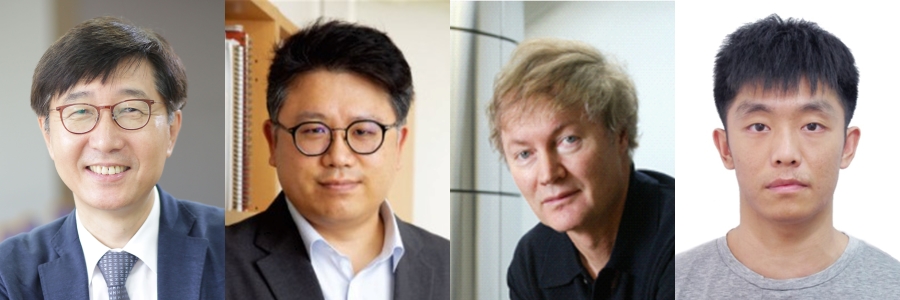Unveiling the Hidden Secrets to Crystal Facets
– Perovskite Solar Cell Stability against Moistures Improved Dramatically
- Discovered the most stable facet (111) against moistures, posted exclusively on US weekly scientific journal, Science
- Prof. Nam Gyu Park’s research team, the first to discover Perovskite Crystal Facet (exposed side of crystal) stable against humidity
- Maintaining more than 95% of initial efficiency in 2000 hours of moisture exposure experiment

▲ (from the left) Prof. Nam-Gyu Park, Prof. Seok Jun Kwon, Prof. Michael Grätzel, Dr. ChunQing Ma
Prof. Nam-Gyu Park, (SKKU Department of Chemical Engineering Chair and Institute of Sungkyun Energy Science Technology Director, corresponding author) and Dr. ChunQing Ma (first author), cooperated with Prof. Seok Jun Kwon (SKKU Department of Chemical Engineering, co-corresponding author), and Prof. Michael Grätzel (Switzerland École Polytechnique Fédérale de Lausanne) to announce their research result about their success in the discovery of stability against moisture depending on Perovskite* Crystal Facets**, producing the film with the most humidity-stable facet (111) and, finally the developing the solar cell that maintained 95% of its original capacity during 2000 hours of humidity exposure experiment on journal Science, January 13th (local time).
* Perovskite: Crystal with chemical formula ABX3. In the crystal, A and X have 12-fold coordination while B and X have 6-fold coordination.
** Crystal Facet: The geometrically flat side of a crystal that has a patterned structure of atom arrangement.
Perovskite solar cells are solar cell technologies that include organic-inorganic hybrid perovskite light-absorbing materials. In 2012, Prof. Park’s research team first developed a solid Perovskite Solar Cell with 9.7% efficiency, pioneering a new academic field called ‘Perovskite Photovoltaics’. Due to this Perovskite Solar Cell development research credits, Clarivate nominated him for the 2017 Novel Prize candidate.
The perovskite light absorption layer for solar cells can be manufactured at a relatively low temperature of 150°C or less using a simple solution process. When a generally known solution process is used, perovskite crystals have polycrystalline properties in the formed film, and crystal facets are not well developed. Prof. Park’s research team succeeded in producing perovskite films with well-developed (100) and (111) crystal facets using additive methods, revealing the photoelectric current dependence according to the facets. In this study, for the first time, they found that moisture stability depends on the facet when the perovskite film is exposed to moisture. In particular, (100) facets are very vulnerable to moisture, but (111) facets are found to be stable to moisture.
Theoretical calculations have shown that (111) facets have better water stability than (100) facets because the adhesion (or wetting energy) of water is relatively low on (111) facets. Also, spectroscopy and X-ray diffraction were used to find that a strong bond with water occurs in the moisture-sensitive (100) facet, resulting in a perovskite phase transition from alpha to delta phase, resulting in loss of light absorption characteristics.
Based on the investigation of the cause of the difference in moisture stability according to facets, it is necessary to develop a film composed of (111) facets to enhance the water stability of the Perovskite Solar Cell. Thus, Prof. Park used an additive called ‘Cyclohexylamine’ to create a Perovskite film of more than 98% (111) facet composition. Testing the stability against moistures under a relative humidity of 30%~40% environment for about 2000 hours (1938 hours), the results showed that solar cells with (111) facet dominant Perovskite film maintained 95% of initial efficiency.
The results of this study were supported by the Ministry of Education, Science and Technology and the Korea Research Foundation (NRF-2021R1A3B1076723) and are expected to significantly improve the life of perovskite solar cells and contribute to commercialization.
※ Paper Title : Unveiling facet-dependent degradation and facet engineering for stable perovskite solar cells
※ Journal: Science















